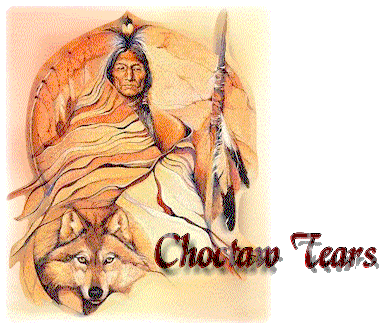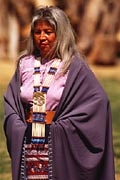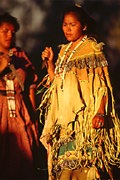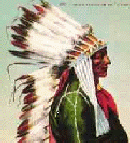
WELCOME, THIS IS A REPORT WRITTEN BY ARCADIA HIGH SCHOOL STUDENTS
WE HOPE YOU FIND IT HELPFUL :)

WE HOPE YOU FIND IT HELPFUL :)
It is a well known fact that in nature only the fittest
survive, the fittest and the most easily adaptable. This ďruleĒ of
nature encompasses everything, including people. We have seen this
rule put to the test time and time again throughout history, and those
people or animals that couldnít live up to the challenge of nature, or
their fellow man- kind, fell away into extinction. In fact, we have
seen this very thing happen pretty recently. When Columbus discovered
America, all the Native Americans were immediately put to the test, trying
to cope with white diseases, new ideas, foreign weapons, and everything
else that followed the first European explorer to America.
Many tribes were pushed to extinction by European pioneers, either killed
by the foreigners or each other. In proportion to the number of tribes
before the time of Columbus, today there are very few surviving Indian
tribes, and most of those are only a fraction of their former glory.
One of the Indian tribes that have managed to hang around are the Apache
Indians. The Apache have had perhaps one of the most trying existences,
yet they have survived to hurdle over all obstacles. This is a reflection
on the strength of their character and shows the durability of the people.
Although the Apache people have lived in what we
know as the United States for the past few hundred years, they originated
from the northwestern corner or North America, the western Subarctic region
of Alaska and Canada. The Apaches actually broke away from
the Athabascan speaking tribe of Canada and were the first band to migrate
as early as AD 850. The Apache were used to living in mountainous
areas and followed the Rocky Mountain range down to the Southwest U.S.
in about 1500. Food in the Subarctic region wasnít very dependable;
the climate didnít allow for too much agriculture and the availability
of game varied with the seasons and climate. In order to survive
the Apache had to constantly move from place to place and this characteristic
of the tribe continued with them even after they migrated south.

 Famous
Apache chief Geronimo
Famous
Apache chief Geronimo

Itís just been recently that the Apache have been
adapting to modern world and accepting some of the ďwhitemanísĒ ideas.
Although life on the reservations is now a little easier than when the
Apache first moved to these designated lands, a very big majority of the
Indians are still living in poverty and unemployment is no stranger.
This does not mean that the Apache are still farmers trading livestock
with one another. In fact the Jicarilla Apache tribe owns thousands
sheep, a large number of horses, and fewer cattle and earn a lot of income
from wool sales. They also get a pretty big amount of revenue from
hundreds of oil and gas wells on the reservation. There are
also the White Mountain Apaches in Arizona who run the Sunrise Ski Resort
and the Fort Apache Timber Company; then thereís the family operated ranch
that provides game hunting on the Mescalera Apache reservation.
There is a fraction of the Apache Indians who do manage to break out of
poverty and carve out a good life for themselves but these few Indians
donít represent the rest of their tribe members.
Many would say that the future of the Apache Indians
doesnít look too bright but this is just the beginning, not the end.
The Apache are strong people and although they are struggling now they
will eventually begin to prosper. More kids are staying in school
and learning the importance of an education and the result of that will
show in future generations. People are finally beginning to recognize
the some of the problems that these kids are having. Children on
the reservations donít take school seriously, they start drugs at a young
age, some drop out of high school and not many move on to college. Kareem
Abdul Jabbar is setting a great example for us all. He wants to see
these kids doing better in school and heís taking action. Kareem
Abdul Jabbar has agreed to coach basketball at the White Mountain Apacheís
high school for the sky-high price of $1 a year. You see, he isnít
doing it for the money, heís doing this because he realizes that these
kids need some sort of motivation to keep them in school and heís willing
to give them that. With help like this the Apache people can make
a better life for themselves, itís just a matter of time. The Apache have
been around for a long time and will continue to prosper for years to come
despite what problems they may face.

LINKS
APACHE
COUNTY ARIZONA
WHITE MOUNTAIN
SKI RESORT
AN APACHE MEDICINE
DANCE
BUREAU OF INDIAN
AFFAIRS
APACHE INDIANS